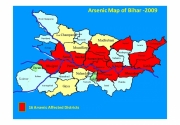/topics/geogenic-contamination
Geogenic Contamination
Arsenic pollution in groundwater in West Bengal – A research report by National Institute of Hydrology
Posted on 28 Jun, 2010 09:08 PMThe report describes the results of the study of arsenic pollution in groundwater in Nadia as well as the hydro-chemical study of the river Hoogly in West Bengal. The alluvial tract along the river Hoogly covering a stretch of around 470 km encompassing eight districts is affected by arsenic pollution of ground water, the source being geogenic.
Arsenic contamination of groundwater in Bihar and mitigation strategies - A research study
Posted on 12 May, 2010 11:24 PM This presentation deals with the problem of arsenic contaminated aquifers in the Gangetic belt of Bihar and the failure of the state government in tackling the crisis and calls for the establishment of a centralized knowledge & research hub with an understanding of the regional peculiarities to mitigate the crisis.
This presentation deals with the problem of arsenic contaminated aquifers in the Gangetic belt of Bihar and the failure of the state government in tackling the crisis and calls for the establishment of a centralized knowledge & research hub with an understanding of the regional peculiarities to mitigate the crisis.
It traces the origin of arsenic crisis to the switch from use of surface water to groundwater. The health impacts of arsenic poisoning and the factors that aggravate arsenicosis are explained. A total of sixteen districts (fifty-seven blocks) in Bihar are affected by high levels of arsenic in groundwater, in trivalent form, which is a more toxic form of arsenic.
Formulating action plan for removal of arsenic contamination in West Bengal - Planning Commission Task Force report
Posted on 12 May, 2010 11:49 AMThe report of the Task Force appointed by the Planning Commission presents an action plan for removal of arsenic contamination in West Bengal. It looks at the extent of the problem, its intake sources, technologies available and the operation and maintenance (O&M) issues.
It outlines the diverse technologies based on various scientific principles, assesses them based on their scale of operation (domestic or community) on techno-economic considerations & infrastructure required and provides suggestions. Short, medium and long term measures are outlined for tackling the problem of arsenic contamination in drinking water supply in the state.
A mid-term assessment - Sachetana drinking water plus project - Fluorosis Mitigation - BIRD-K - Mundargi taluk - Gadag district (Karnataka)
Posted on 29 Jan, 2010 06:02 PMThe Sachetana Drinking Water Plus project implemented by the BAIF Institute of Rural Development (BIRD-K), in three districts of Karnataka, aims to solve the problem of endemic fluorosis in the region, by providing an alternate source of water and by improving the quality of groundwater.
This report is a mid-term assessment of the project in Mundargi taluk of Gadag district of Karnataka, undertaken to understand and document the decentralized fluoride mitigation strategy adopted in the project villages and to analyze the impact on the groundwater levels and water quality as a result of the project's efforts.
A community based self-sustained safe drinking water program - An industry case study from the work of BOSCH Limited - Jaipur
Posted on 17 Nov, 2009 05:38 PM
This work won the CII-GBC National Award (Beyond the Fence Category) for Excellence in Water Management in 2008.
Download the presentation from below:
Arsenic contamination in ground water of Bihar and its mitigation strategy
Posted on 31 Oct, 2009 09:21 PMArsenic contaminated aquifers in a 5 km. wide study belt along the banks of river Ganga, in Patna, Bhojpur, Vaishali and Bhagalpur districts of Bihar, are used for both drinking and irrigation purposes.
Case studies on drinking water from Whitman Direct Action's "Water Book"
Posted on 09 Sep, 2009 11:22 AMSujala Scheme: The Byyraju Foundation's manual for setting up a locally managed, rural drinking water plant. The Foundation's drinking water initiative covers 154 villages across five districts of Andhra Pradesh via 31 village-level treatment plants.
Read More (Size: 2.1 MB)
Byrraju Foundation website
Arsenic contamination of irrigation water, soil and crops in Bangladesh: A paper from the UN Food and Agriculture Organisation
Posted on 29 Aug, 2009 12:53 PMArsenic contamination of irrigation water, soil and crops in Bangladesh: Risk implications for sustainable agriculture and food safety in Asia.
Remediation of arsenic for agriculture sustainability, food security and health in Bangladesh
Posted on 29 Aug, 2009 11:44 AMArsenic (As) in groundwater is a major health concern in Asia and the risks from using shallow tube wells (STWs) for drinking-water are well- known. At present, twelve countries in the Asian region have reported high As levels in part of their groundwater resources.
Maps depicting the arsenic contamination in the Ganga-Meghna-Brahmaputra plains between 1976 and 2008
Posted on 20 Aug, 2009 06:11 PMThe School of Environmental Studies - Jadavpur University (SOES-JU), has done path-breaking research in reporting and documenting the issue of Arsenic contamination in the country.





